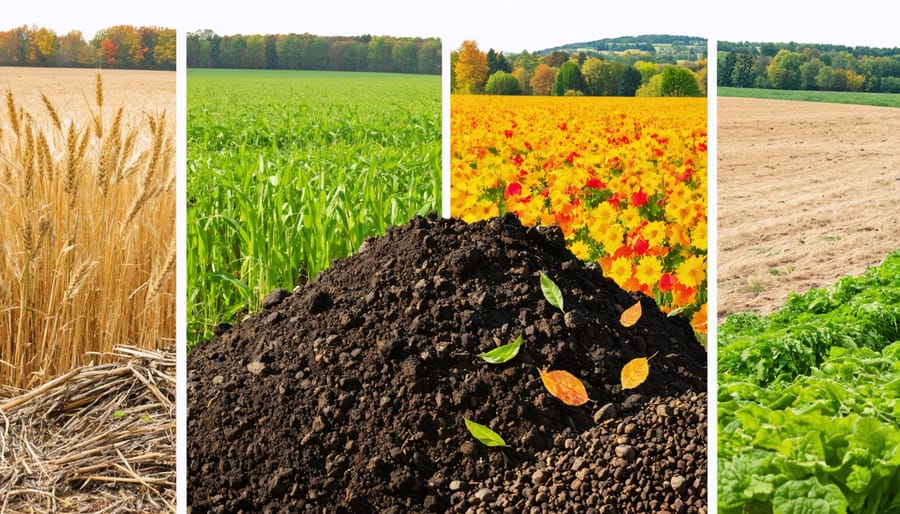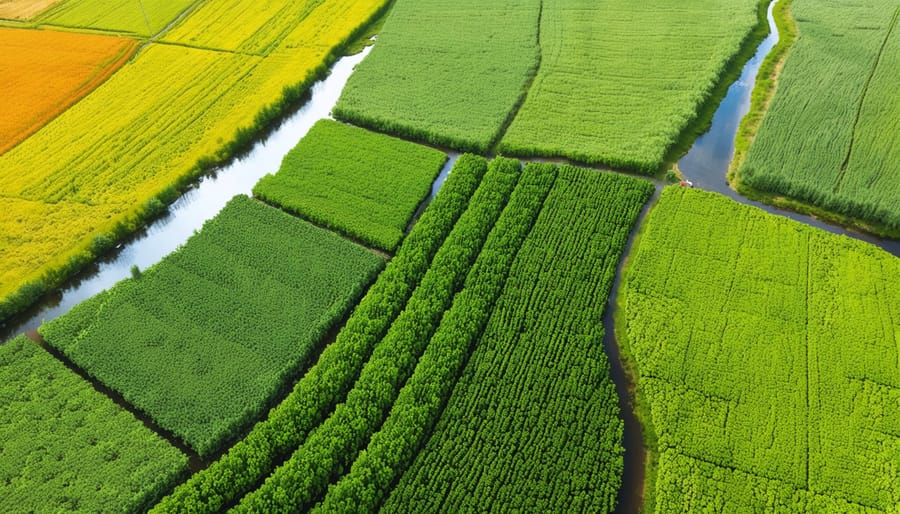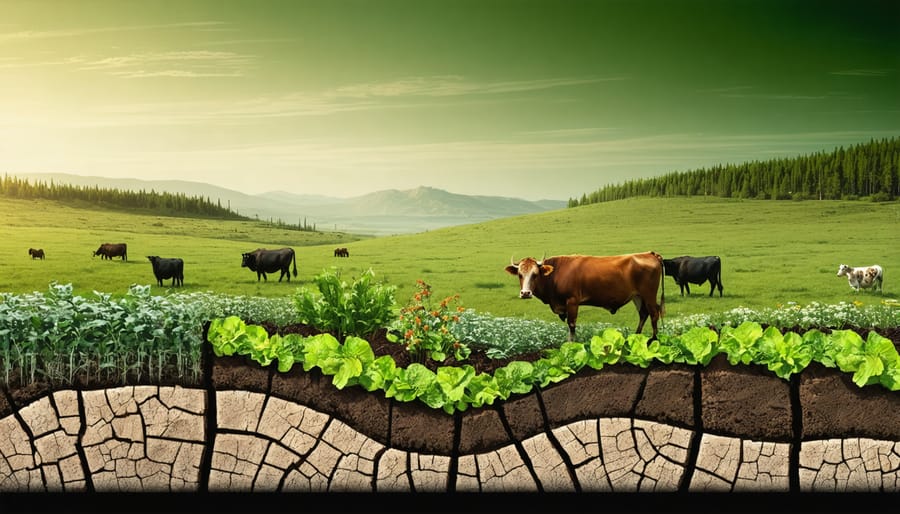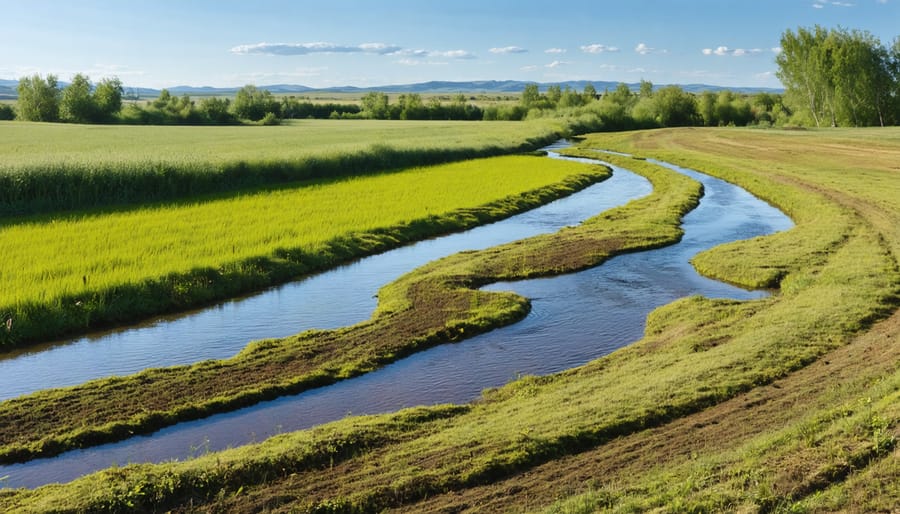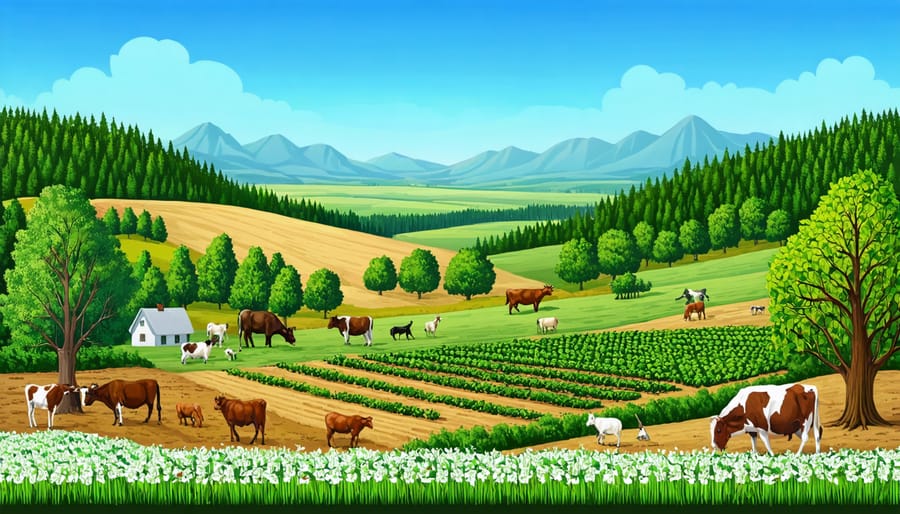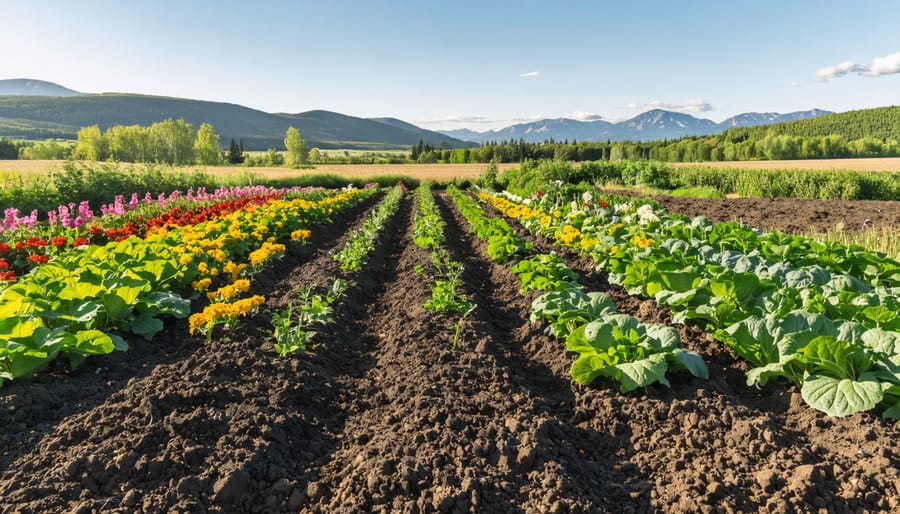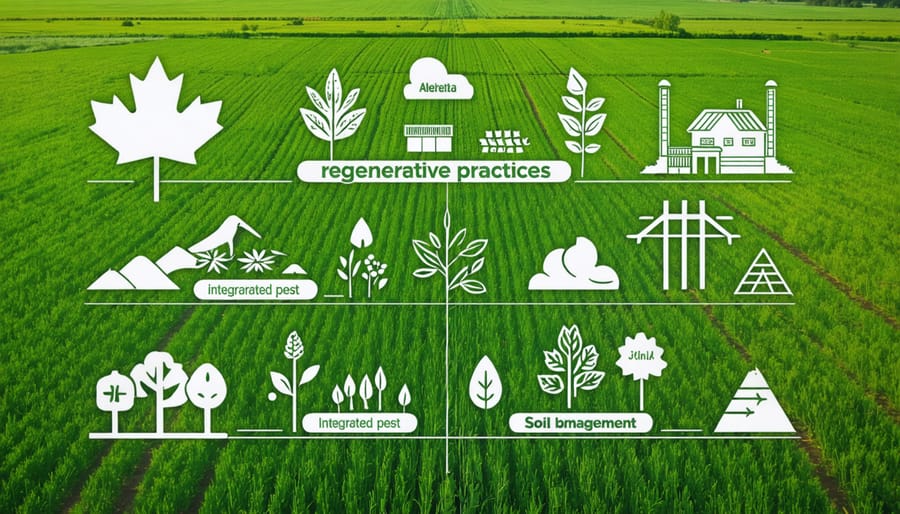Plant biodiversity stands as the cornerstone of resilient farming systems across Alberta’s diverse agricultural landscape. Through regenerative agriculture practices, farmers are discovering that increased plant diversity delivers measurable benefits: enhanced soil structure, improved water retention, and stronger natural pest resistance. On successful Alberta farms, each additional plant species introduces unique root structures and nutrient cycling patterns, creating a robust underground ecosystem that supports sustainable crop yields.
Recent field studies from Prairie farming communities demonstrate that fields with eight or more plant species show 23% higher productivity compared to monoculture systems. This productivity boost translates directly to the bottom line, with diversified farms reporting reduced input costs and greater resilience during extreme weather events. For Canadian farmers, particularly in Alberta’s variable climate, plant biodiversity represents more than ecological stewardship – it’s a practical strategy for long-term farm viability.
By integrating cover crops, companion planting, and strategic crop rotations, producers across the province are building living soil systems that work in harmony with natural processes, ensuring both environmental sustainability and economic prosperity for future generations.
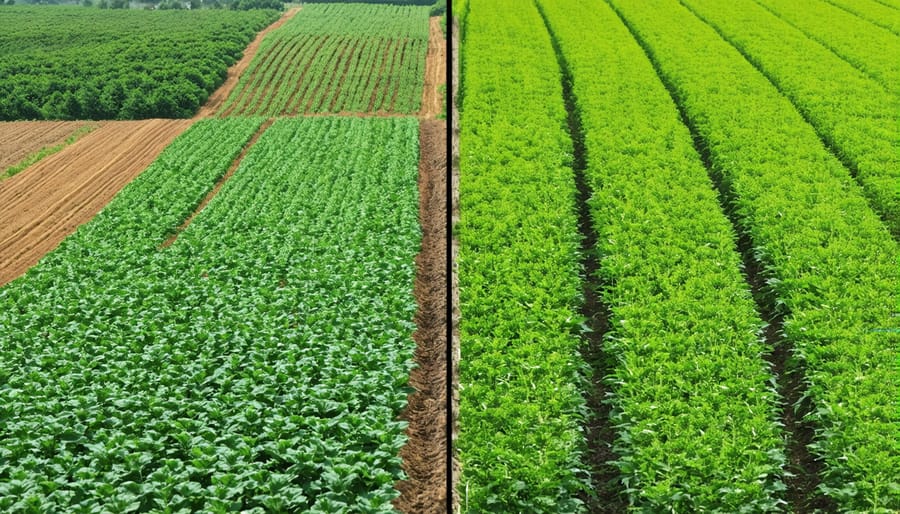
Why Plant Biodiversity Matters for Your Farm
Soil Health and Nutrient Cycling
A diverse plant community acts as a natural engine for soil health and nutrient cycling, creating a robust underground ecosystem that benefits your entire farm. Different plant species have varying root depths and structures, which help break up compacted soil and create channels for water infiltration. Here in Alberta, we’ve seen remarkable improvements in soil structure when farmers integrate multiple species into their rotation.
Each plant species contributes unique organic compounds to the soil through root exudates, supporting diverse microbial communities. For example, legumes fix nitrogen, while deep-rooted plants like alfalfa bring up nutrients from lower soil layers. This natural nutrient mining reduces the need for synthetic inputs and builds long-term soil fertility.
The diversity above ground translates to diversity below ground, with different plants supporting various beneficial fungi and bacteria. These microorganisms break down organic matter, making nutrients more available to crops and improving soil aggregation. Many Alberta farmers report better drought resilience and reduced erosion after increasing their plant diversity, demonstrating how nature’s systems work together to build healthier soils.
Natural Pest Management
One of the most remarkable benefits of plant biodiversity is its natural pest management capabilities. When you maintain diverse plant species in your fields, you create a robust ecosystem that naturally keeps pest populations in check. Here in Alberta, farmers who’ve implemented diverse crop rotations report significantly lower pest pressure compared to monoculture systems.
Beneficial insects like ladybugs, ground beetles, and parasitic wasps thrive in diverse plantings, providing free pest control services. For example, the MacDonald family farm near Red Deer saw a 60% reduction in aphid populations after introducing flowering strips between their canola fields, which attracted natural predators.
Different plant species emit varying chemical signals that can confuse and deter pests, making it harder for them to locate their preferred host plants. Additionally, incorporating aromatic herbs and flowers throughout your crops can repel certain pests while attracting pollinators. Companion planting strategies, such as growing dill and carrots together or planting marigolds near vegetables, have proven particularly effective in our prairie growing conditions.
By supporting natural pest management through biodiversity, you can reduce reliance on chemical interventions while building a more resilient farming system.
Biodiversity Success Stories from Alberta Farms
Prairie Grain Operation Transformation
Tom Anderson’s 800-hectare grain operation near Red Deer, Alberta, stands as a testament to the power of agricultural biodiversity. Five years ago, his farm struggled with declining yields and increasing input costs. Today, his operation serves as a model for sustainable farming practices in the prairie region.
“I was skeptical at first,” Anderson admits, “but the numbers don’t lie. Since introducing crop diversity, our yields have increased by 23% while reducing our fertilizer usage by almost a third.” His transformation began by expanding beyond the traditional wheat-canola rotation to include pulses, cover crops, and heritage grain varieties.
Anderson’s new rotation includes yellow peas, fava beans, and winter wheat, interspersed with diverse cover crop mixtures. These changes have improved soil structure, increased organic matter content, and created habitat for beneficial insects. The variety of root systems at different depths has enhanced water retention and nutrient cycling in his soil.
The financial benefits have been significant. Despite initial investment in new equipment and seeds, Anderson’s operation now saves approximately $75,000 annually on input costs. Local wildlife has returned to the farm, including beneficial predatory birds that help control pest populations naturally.
“The key was starting small,” Anderson explains. “We began with trial plots and gradually expanded as we saw results. Now, other farmers in the area are adopting similar practices after seeing our success.”
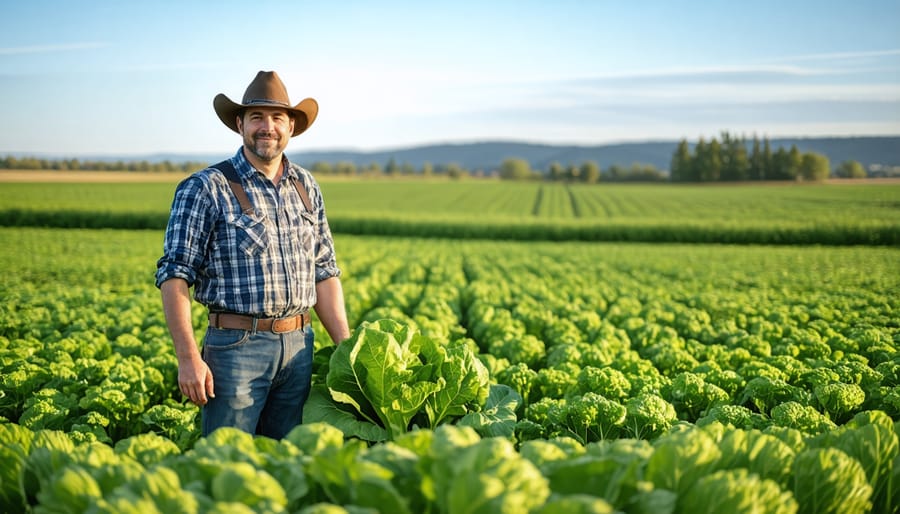
Mixed Farming Success
The Peterson family farm in Red Deer County stands as a shining example of successful mixed farming practices that enhance plant biodiversity. Over the past decade, Sarah and Tom Peterson have transformed their 640-hectare operation by integrating cattle grazing with diverse crop rotations.
Their system includes rotating beef cattle through pastures of mixed native grasses and legumes, while maintaining fields of various grains, pulses, and cover crops. “We’ve seen remarkable improvements in soil health since introducing this diversity,” shares Sarah. “Our cattle help cycle nutrients naturally, and the varied root systems of different plants keep our soil structure strong.”
The Petersons’ approach includes spring wheat, barley, and field peas in rotation, complemented by cover crop mixtures containing radishes, clover, and vetch. These cover crops serve multiple purposes: providing additional grazing for livestock, improving soil structure, and supporting beneficial insects.
The results speak for themselves. Since implementing these changes, the Petersons have reduced their fertilizer use by 30% while maintaining yields. Soil organic matter has increased from 2% to 4.5%, and they’ve documented 23 different native plant species in their pastures, up from just 8 species ten years ago.
Their success has inspired neighbouring farms to adopt similar practices, creating a growing network of biodiversity-focused operations in central Alberta. The farm regularly hosts field days, sharing their experiences with other farmers interested in mixed farming systems.
Practical Steps to Enhance Plant Biodiversity
Cover Crop Selection and Management
In Alberta’s diverse agricultural landscape, selecting the right cover crops plays a crucial role in enhancing plant biodiversity and soil health. For best results, consider a mix of at least three different species from varying plant families. Popular combinations include cereals like fall rye or winter wheat, legumes such as field peas or hairy vetch, and brassicas like radish or turnip.
When choosing cover crops, assess your specific goals and field conditions. For example, if soil compaction is an issue, deep-rooted species like tillage radish can help break up hard layers. If nitrogen fixation is needed, incorporate more legumes into your mix. Consider your growing season length – many Alberta farmers find success with cold-tolerant varieties that can establish quickly after harvest.
Timing is everything with cover crop management. For southern Alberta, seed winter-hardy species between late July and early September. In central and northern regions, earlier seeding may be necessary. Monitor soil moisture at planting, aiming for adequate but not excessive levels for good germination.
For termination, several methods work well in our climate. Winter kill is nature’s solution for some species, while others may require spring termination through crimping, mowing, or herbicides. Remember to plan your termination strategy before planting to ensure it aligns with your next cash crop’s needs.
Many Alberta farmers report success with cocktail mixes that include both warm and cool-season species, providing extended soil coverage and diverse root structures throughout the growing season.
Crop Rotation Strategies
Effective crop rotation is a cornerstone of maintaining plant biodiversity on Alberta farms. A well-planned three to four-year rotation cycle not only breaks pest and disease cycles but also enhances soil health and promotes diverse plant communities.
For Alberta’s climate, consider starting with a cereal crop like wheat or barley, followed by a nitrogen-fixing legume such as field peas or fava beans. In the third year, introduce an oilseed crop like canola, and consider adding a cover crop mix in the fourth year. This approach maximizes both economic returns and biodiversity benefits.
Local farmer Dave Thompson from Lacombe County shares, “Since implementing a diverse rotation including pulse crops and cover crop cocktails, we’ve seen a 30% increase in beneficial insects and improved soil structure across our 800 hectares.”
To enhance biodiversity further, consider these proven strategies:
– Incorporate flowering cover crops between main seasons
– Plant buffer strips with native prairie species
– Alternate deep and shallow-rooted crops
– Include both warm and cool-season plants
– Mix cereals with broadleaf crops
For smaller operations, intercropping compatible species like peas and barley can maximize space while boosting biodiversity. Remember to adjust your rotation plan based on soil tests, local climate patterns, and market demands. Many Alberta farmers find success by starting with a simple three-crop rotation and gradually increasing complexity as they gain experience.
Integration with Existing Operations
Integrating plant biodiversity into existing farming operations doesn’t have to be disruptive or overwhelming. Many Alberta farmers have successfully enhanced biodiversity through gradual implementation, starting with small test plots before scaling up. The key is to identify natural transition points in your current rotation system where diversity can be introduced without compromising productivity.
Consider incorporating cover crops during fallow periods or implementing no-till organic methods in sections of your field. Intercropping, where two or more crops grow together, can be introduced on a trial basis, such as combining canola with field peas, a practice gaining popularity across the prairies.
Start by identifying your least productive field sections and use these areas for biodiversity experiments. This approach minimizes risk while allowing you to observe benefits firsthand. Many successful farmers begin with buffer strips along field edges or windbreaks, gradually expanding as they become comfortable with management techniques.
Local agricultural extension services offer support for transition planning, and numerous farmer-led networks in Alberta share practical experience and strategies. Remember, biodiversity enhancement doesn’t require a complete system overhaul – even small changes, like adding one new crop variety annually or establishing pollinator-friendly corridors, can make meaningful contributions while maintaining operational efficiency.
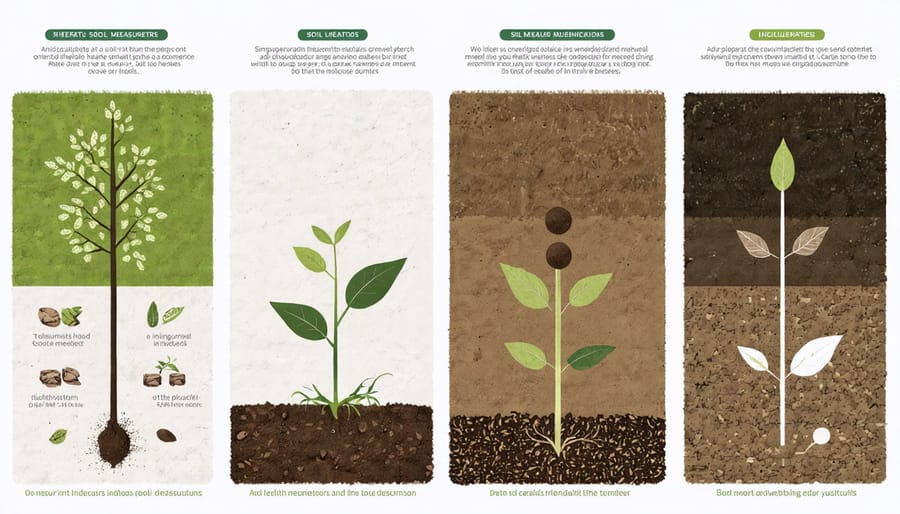
Measuring and Monitoring Success
Key Indicators to Track
To effectively monitor plant biodiversity on your farm, focus on these measurable indicators that work alongside key soil health indicators. Start by tracking your plant species count, including both crops and beneficial weeds, aiming for at least 10-15 different species per hectare. Document flowering periods throughout the growing season, targeting continuous bloom coverage from early spring through late fall.
Monitor beneficial insect populations by conducting weekly visual surveys during peak growing seasons. Keep records of native pollinators, particularly noting the presence of various bee species common to Alberta. Track your crop yield stability across seasons, as diverse systems typically show more consistent production despite weather challenges.
Consider implementing annual soil biological assessments and maintaining photo records of field conditions. Many Alberta farmers find success using smartphone apps for species identification and data collection. Remember to note the presence of indicator plants – certain species that naturally appear in healthy, diverse systems. These measurements, when tracked consistently, provide valuable insights into your farm’s biodiversity progress and overall ecosystem health.
Simple Assessment Methods
Measuring plant biodiversity on your farm doesn’t need complex equipment or scientific expertise. Start by establishing several 1-metre square plots across different areas of your land. Within each plot, count the number of different plant species you can identify. Take photos or collect samples of unknown plants for later identification.
Another simple method is the “W” walk pattern across your field. Walk in a W shape, stopping every 10 metres to record plant varieties. This gives you a good representation of species distribution throughout your land. For orchards or shelterbelts, count species along a straight 100-metre transect line.
Keep seasonal records using a basic spreadsheet or notebook. Note flowering times, dominant species, and any new plants that appear. Many Alberta farmers find spring and fall are ideal for these assessments, as most plants are either flowering or going to seed.
Local agricultural extension offices often provide plant identification guides specific to our region, making the process more straightforward. Consider joining community biodiversity monitoring programs, where you can share findings with neighbouring farmers and learn from their experiences.
As we’ve explored throughout this article, plant biodiversity offers tremendous potential for Alberta’s agricultural landscape. By incorporating diverse plant species into our farming systems, we’re not just improving soil health and crop yields – we’re building resilient farming operations that can better withstand climate challenges while supporting local ecosystems.
The path forward is clear: start small, monitor results, and gradually expand successful practices. Whether it’s introducing cover crops, implementing crop rotation, or establishing beneficial hedgerows, every step toward greater biodiversity makes a difference. Remember that you’re not alone in this journey – Alberta’s farming community is increasingly embracing these practices, and support networks are growing stronger.
Consider connecting with local agricultural extension services, joining farmer-led learning groups, or participating in field days to share experiences and learn from others. The Alberta Soil Health Coalition and various regional agricultural societies offer valuable resources and networking opportunities.
Looking ahead, maintaining plant biodiversity will become increasingly crucial for sustainable agriculture in our region. By taking action now, you’re not just preparing your farm for the future – you’re contributing to a larger movement toward more sustainable and profitable farming practices in Alberta.
Take that first step today, whether it’s planning your first cover crop or reaching out to experienced farmers in your area. Your actions today will help shape the future of agriculture in our province.



